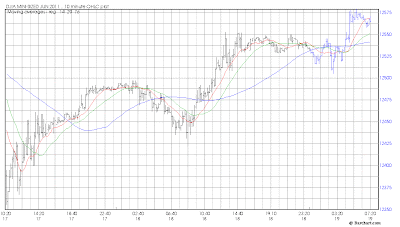Stock futures continued the rally as predicted last week. I'm waiting on a short entry point.
It's time to reiterate the strategic view. In Mid-May I1 issued a formal sell signal which will last until mid-August. This signals occurs when I1 peaks below +7 and begins a decline that takes it below 3.25.
Usually I1 is accurate for the short-term (less than 2 week) for the stock market as well, but the Japan quake temporarily induced an 8-day lead into the series. I believe that the distortion is now leaving human behavior.
USGS, Japanese earthquake specialists, and NASA have formed some conclusions about the Japan quake.
The Richter 9 quake probably shifted the position of Earth's axis about 6.5 inches, said Richard Gross, a geophysicist at the Jet Propulsion Laboratory in La Canada Flintridge, in an e-mail.
The temblor also should have caused Earth to rotate somewhat faster, shortening the length of the day by about 1.8 microseconds, he said.
Data-crunchers had determined that the temblor's force moved parts of eastern Japan as much as 12 feet closer to North America, scientists said, and that Japan has shifted downward about two feet.
USGS had determined that the entire earthquake sequence -- including associated foreshocks and aftershocks -- had included 200 temblors of magnitude 5 or larger, 20 of which occurred before the big quake hit.
Earth's rotation changes all the time as a result of not only earthquakes, but also the much larger effects of changes in atmospheric winds and oceanic currents," he said. "Over the course of a year, the length of the day increases and decreases by about a millisecond, or about 550 times larger than the change caused by the Japanese earthquake. The position of Earth's figure axis also changes all the time, by about 1 meter (3.3 feet) over the course of a year, or about six times more than the change that should have been caused by the Japan quake."
Gross said that while we can measure the effects of the atmosphere and ocean on Earth's rotation, the effects of earthquakes, at least up until now, have been too small to measure. The computed change in the length of day caused by earthquakes is much smaller than the accuracy with which scientists can currently measure changes in the length of the day. However, since the position of the figure axis can be measured to an accuracy of about 5 centimeters (2 inches), the estimated 17-centimeter shift in the figure axis from the Japan quake may actually be large enough to observe if scientists can adequately remove the larger effects of the atmosphere and ocean from the Earth rotation measurements.
Since some of I1 inputs include atmospheric and oceanographic currents projected into the futures it would make sense that such a large quake and the pre- and after-shocks would alter these natural phenomenon. The earth's magnetic field is a sensitive tuning fork which will return to the pitch predicted. The belief that I1 is now returning to synchronization in it's predictive ability is indicated by the first complete cycle since the quake in it's sensitive short-term timing component, which reflects the effects of solar and lunar position on the earth's magnetic field. This is now indicating that Wednesday is the first potential top date in it's current up-cycle.
The I1 prediction of a decline into mid-August is confirmed by cycle data which I have been laboring to bring up to date. The cycles detected in DJI indicate a bottom in September.
The cycles detected in S&P500 also reflect this same time horizon for a decline.
With cycle data the normal caveats apply, that this is looking backward at fixed cycles over the past 50 years. Said cycles swing into precision and out again and this data source is not as reliable as I1.



















































